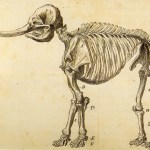Extinction
Sixty-five million years ago, life on Earth was sorely tested. One or more catastrophic events including a massive asteroid strike and increased volcanic activity, created wildfires on a global scale and dust clouds that cut the planet's surface off from the sun's vital light. The majority of animal species went extinct including, most famously, the dinosaurs. The fate of the planet's plants is less familiar, but 60% of those also perished. What separated the survivors from the deceased? How did some species cross this so-called "K/T boundary"?
Jeffrey Fawcett form the Flanders Institute for…
The emperor penguin - caring parent, extreme survivor and unwitting movie-star - could be marching to extinction by the turn of the next century. In its Antarctic home, the penguins frequently have to deal with prolonged bouts of starvation, frosty temperatures of -40 degrees Celsius, and biting polar winds that blow at 90 miles per hour. And yet this icy environment that so brutally tests the penguins' endurance is also critical to their survival. This is a species that depends on sea ice for breeding and feeding.
So what will happen to the emperor penguin as Antarctica's sea ice shrinks,…
One of the most interesting and exciting stories in science is that of the Younger Dryas. The Younger Dryas was a climate event that had important effects on human history, and that has been reasonably linked to some of our most important cultural changes, and ultimately some evolutionary changes as well. That is one reason why it is interesting. In addition, the Younger Dryas was a pretty big deal ... a climate change or something like a climate change that caused massive changes all around the earth, and fairly recently. But the cause of the Younger Dryas is at present unknown, although…
Linepithema flavescens, last seen in 1934
Linepithema flavescens, a small yellow ant from Haiti, is one of the species I re-described as part of my Ph.D. dissertation. All we know about this ant, apart from the brief notes on the specimen labels, is the external appearance of a few workers. Queens and males haven't been collected. No one has studied its ecology or behavior. The few existing museum specimens- gathered from two different field sites- may be too valuable to attempt DNA extraction.
A 1934 collection is the last time anyone has ever seen L. flavescens…
Personally, I think we should start with a dodo, and then work our way up the ethical ladder from there.
... We know roughly how the sequence of life ran forward in time. What about running it backward? ...
Last week in Nature, scientists reported major progress in sequencing the genome of woolly mammoths. [see this] ... Now, according to Nicholas Wade of the New York Times, biologists are discussing "how to modify the DNA in an elephant's egg so that after each round of changes it would progressively resemble the DNA in a mammoth egg. The final-stage egg could then be brought to term in…
tags: po'ouli, Melamprosops phaeosoma, endangered species, endangered species act, conservation, extinction, birds, island species, Hawai'i, book review
For scientists, naturalists and birders, islands are the most amazing places on earth because their evolutionary legacy has provided them with their own fascinating flora and fauna that are found nowhere else in the world. But because humans also like to live on islands, along with their pets and crop plants, islands are a conservation nightmare, and certainly, the Hawai'ian islands are no exception. In Alvin Powell's book, The Race to Save…
A quick wrap-up of the animals discovered not to be extinct this week:
Armoured mistfrog
This Armoured Mistfrog, thought by many experts to be extinct due to the recent amphibian chytrid fungus epidemic, was rediscovered by my boss, enterprise search god, Chris Cleveland, while he should have been working, on CNN. And more specifically, in a remote tropical area in northern Australia.
Tadpole Shrimp
Heavy rains in Scotland have created perfect conditions for the reemergence of the tadpole shrimp, thought extinct in the UK until recently. The little critter resembles a tiny horseshoe crab…
tags: dinosaurs, Tarbosaurus bataar, paleontology, fossils, Tyrannosaurs rex
The newly unveiled fossil skeleton of the juvenile Tarbosaurus bataar in its protective jacket.
Discovered in 2006, a near-perfect complete skeleton of a juvenile Tarbosaurus find was made available for public viewing for the first time today by the Hayashibara Museum of Natural Science in Okayama, western Japan. This fossil was originally unearthed from a chunk of sandstone in the Gobi Desert of Mongolia by a team of Mongolian and Japanese researchers. The fossil of the young dinosaur is roughly 70 million years…
tags: researchblogging.org, phylogeny, British birds, population decline, range contraction, Gavin H Thomas
An adult male Eurasian blackbird, Turdus merula.
Image: Wikipedia commons [larger view].
A paper recently published by British scientist, Gavin Thomas, a population biologist at Imperial College London, finds that British bird species that currently are suffering population declines tend to be close relatives of each other. The reason is obvious: closely related species tend to share many traits, such as very precise habitat requirements, and what's bad for one species is also bad…
Dinosaur tracks are reported for the first time on the Arabian Peninsula. These new tracks are located in Yemen. This find is interesting and important for several reasons.
You can place all the dinosaur remains from Arabia on one table, which is what they used to say about human fossil before several tens of thousands of human ancestor bits and pieces were eventually accumulated. But this does not mean that we don't know much about Arabian Dinosaurs. Back in the days of dinosaurs, the big triangular-shaped piece of land known as Arabia was firmly attached to, and indeed, totally part of,…
Let's say we're having a nice day here on Earth; the Sun is shining, the clouds are sparse, and everything is just looking like a peach:
And then Lucas goes and tells me,
Oh my God, Ethan! It's Armageddon! An asteroid is coming straight for us! You've got to stop it!
Really? Me? Well, how would I do it? Let's say we've got some reasonably good asteroid tracking going on, and we've got about 2 months before the asteroid is actually going to hit us. We'd like to do something with the situation on the left, to avoid the situation on the right:
Well, what we really have to do is change the…
When Life Nearly Died: The Greatest Mass Extinction of All Time is a book by Michael Benton on the Permian Extinction now out in paperback. From the press release:
Today it is common knowledge that the dinosaurs were wiped out by a meteorite impact sixty-five million years ago, which killed half of all species then living.
Far less well-known is a much bigger catastrophe - the greatest mass extinction of all time - which occurred 251 million years ago, at the end of the Permian period. In this cataclysm, at least ninety per cent of life was destroyed, both on land, including sabre-toothed…
Ever since 3,599 years ago humans have been asking the question "Why did our furry elephant go extinct?"
What caused the woolly mammoth's (not to be confused with the also-woolly mastodon) extinction? Climate warming in the Holocene might have driven the extinction of this cold-adapted species, yet the species had survived previous warming periods, suggesting that the more-plausible cause was human expansion.
The woolly mammoth went extinct less than four thousand years ago. The bones of miniaturized woolly mammoths have been found in Siberia dating to about 3,600 years ago. Indeed,…
A very important and truly wonderful paper in Nature described a tour-de-force analysis of the Mammalian Evolutionary Record, and draws the following two important conclusions:
The diversification of the major groups of mammals occurred millions of years prior to the KT boundary event; and
The further diversification of these groups into the modern pattern of mammalian diversity occurred millions of years later than the KT boundary event.
The KT boundary event is the moment in time when a ca. 10 km. diameter object going very fast hit the earth in the vicinity of the modern Yucatan,…
In 1833, Darwin spent a fair amount of time on the East Coast of South America, including in the Pampas, where he had access to abundant fossil material. Here I'd like to examine his writings about some of the megafauna, including Toxodon, Mastodon, and horses, and his further considerations of biogeography and evolution.
In the vicinity of Rio Tercero...
Hearing ... of the remains of one of the old giants, which a man told me he had seen on the banks of the Parana, I procured a canoe, and proceeded to the place. Two groups of immense bones projected in bold relief from the perpendicular…
Proposals to give the latter part of the present geological period (the Holocene) a new name ... the Anthropocene ... are misguided, scientifically invalid, and obnoxious. However, there is a use for a term that is closely related to "Anthropocene" and I propose that we adopt that term instead.
The pithy title of the paper making this proposal is "Are we now living in the Anthropocene" (sic: no question mark is included in this title, enigmatically).
It is not an entirely stupid idea. The paper argues that there are major changes of the type often used to distinguish between major…

Did humans wipe out the Pleistocene megafauna? This is a question that can be asked separately for each area of the world colonized by Homo sapiens. It is also a question that engenders sometimes heated debate. A new paper coming out in the Journal of Human Evolution concludes that many Pleistocene megafauna managed to go extinct by themselves, but that humans were not entirely uninvolved.
The paper by Pushkina and Raia ("Human influence on distribution and extinctions of the late Pleistocene Eurasian megafauna") examines sources in the literature and a number of databases for Eurasian…
The end-Permian mass extinction event was the big daddy of all the known mass extinction events. Life on the planet Earth was almost entirely wiped out. A new paper explores the post-extinction recovery of ecological systems.
Post extinction dynamics can be understood in relation to several dimensions: Taxonomy (the range and structure of different taxonomic groups); ecology (the interrelationship between the new species and the niches available, as well as the structure and distribution of those niches); and morphology (the overall morphospace filled by the new taxa). The present study…
An international consortium of zoos, aquariums, conservation organizations and scientists, calling itself the "Amphibian Ark," has dubbed 2008 the "Year of the Frog." Amphibian Ark made the declaration in order to draw awareness to the mass extinction of amphibian species around the globe and to infuriate the Chinese, who already named the year after the rat "like 5000 years ago". The AArk is a joint effort of 3 principal partners: the World Association of Zoos and Aquariums (WAZA), the IUCN/SSC Conservation Breeding Specialist Group (CBSG), and the IUCN/SSC Amphibian Specialist Group (ASG…
I try to visit the AMNH in New York City as often as I can, but it looks like I'll be making a few extra trips this coming November. While the exhibits alone are worth a visit, the museum often plays host to various scientists and authors as well, and it appears that they'll be running at least three public talks next month focusing on conservation and extinction.
On November 13th, David S. Wilcove from Princeton University will be speaking about his book (just released this week) No Way Home which covers animal migrations and the pressures they're facing from human activities. While I haven'…

